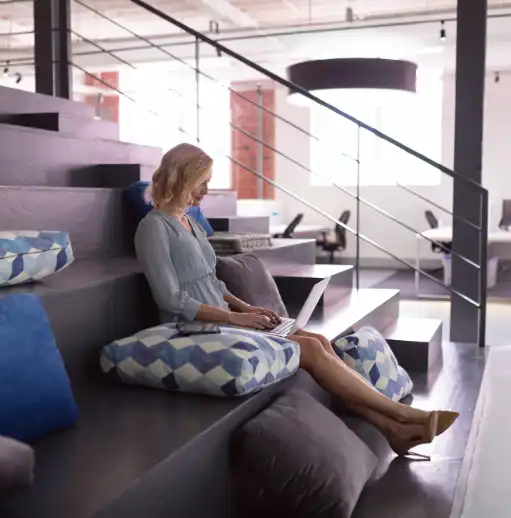David Dewane is the Chief Experience Officer for Physical Space at Geniant, where he’s passionate about exploring the intersection of space, people, and technology in the workplace. Host Mike Petrusky interviews Dewane about the understanding of employees’ needs and experiences, the evolution of workplace design, and the role of technology in creating more effective and engaging work environments. Dewane states that by gauging the reality of the experiences their teams encounter and obtaining genuine insights through research, facilities management and corporate real estate leaders can evolve their approach to workplace design, rather than reverting to outdated models. Mike P and Dewane discuss the importance of helping individuals shift from a defensive mindset to a discovery mindset, allowing them to foster innovation and adapt to changing workplace strategies.
Agenda
- The role of physical space in employee experience
- Challenges and opportunities in the workplace of 2025
- The importance of understanding team needs through research and design
- The impact of culture and creativity on the workplace
- Why facility managers should adopt a more discovery-oriented mindset
What you need to know: Workplace takeaways
Takeaway 1: Understanding the current reality of workplace teams is crucial for effective facility management.
David Dewane, the Chief Experience Officer for Physical Space at Genient, emphasizes the importance of understanding the current reality of workplace teams to make informed decisions. “You have to try set up a budget to get some researchers involved that can help you actually understand the reality of your teams in the workplace right now,” says Dewane. He further explains, “Otherwise you’re just at risk of wasting money and time and losing talent and falling by.”
He suggests that if you have $1 to spend, it should go to an anthropologist to uncover what is truly happening in the workplace. “They can tell you what’s really going on, that’s the most important thing,” he states. Dewane also notes that companies are already spending on research for technology projects, and the same level of investment should be made for understanding the physical space. “They’re just doing it on all the technology projects that they’re working on. They’re just not doing it on the space projects yet. And I think that that’s where you’ve got to go,” he adds.
Takeaway 2: The workplace should be designed to enhance the performance and well-being of its occupants.
Dewane draws a distinction between functional and performative spaces, highlighting the importance of creating environments that not only serve their basic purpose but also enhance the performance and well-being of the people within them. “There’s a distinction in my mind that once I saw it, I couldn’t unsee it. And this comes from Rem Koolhaas, maybe the greatest living architect right now, and he said he draws a distinction between spaces that are functional and spaces that are performative,” Dewane explains. He elaborates, “A functional space is boring, whatever it is. But a performative space is one that makes people more effective.”
Dewane further emphasizes that the workplace should be designed to match the “frequency” of the team’s needs. “The workplace should make a team more effective, and specifically it should make them more effective along the lines whatever it is that they’re doing,” he says. This means that a marketing group should find their workspace makes them more effective marketers, and a law firm should find their space enhances their effectiveness as lawyers.
Takeaway 3: Adopting a discovery mindset is essential for facility managers to innovate and improve the workplace.
Dewane discusses the concept of moving from a defensive to a discovery mindset, drawing parallels from the movie “The Breakfast Club” to illustrate the benefits of being open to new ideas and experiences. “I know it sounds kind of corny, but I would just say really meet the moment, you know, like there is an opportunity right now to take a serious evolutionary step,” Dewane says. He notes that while many facility managers are in a defensive mindset due to shrinking portfolios and uncertain ROI, the key is to find a compass point and start making decisions based on real intelligence.
“Once you have that understanding, terra firma. Which you don’t have right now unless you’ve done this. Then if you have a 2nd dollar, give it to a designer who can co-design with that group of people, an environment that will make them happier and more productive,” he advises. Dewane encourages facility managers to take incremental steps towards improvement rather than making drastic changes, and to focus on understanding the people they serve. “It requires you to take the time to understand the people that you’re serving. And companies like Geniant are built to do this,” he concludes.
Workplace management insights
- The importance of integrating ethnography and anthropology in the design of physical spaces to better meet the needs of users.
- The distinction between functional and performative spaces, with performative spaces enhancing the effectiveness of the people using them.
- The concept of “anti-fragility” and its relevance to the workplace, where a discovery mindset can lead to more effective and happier teams.
- The need for facility managers to move from a defensive to a discovery mindset to adapt to the changing nature of work.
- The importance of investing in research to understand the reality of teams in the workplace, which can prevent wasting resources and losing talent.
- The role of place in enhancing psychophysical well-being and productivity, drawing from Seinfeld’s analogy of a place being like a tuning fork.
- The idea that incremental improvements, rather than radical changes, can lead to a more positive and engaging workplace environment.
Do a deep dive into more workplace insights by exploring all Workplace Innovator podcast episodes.





